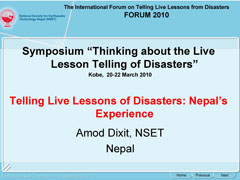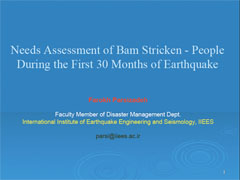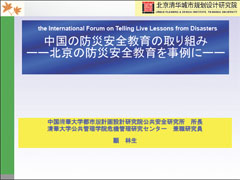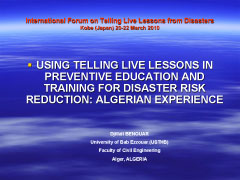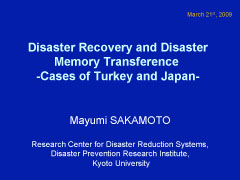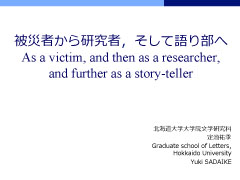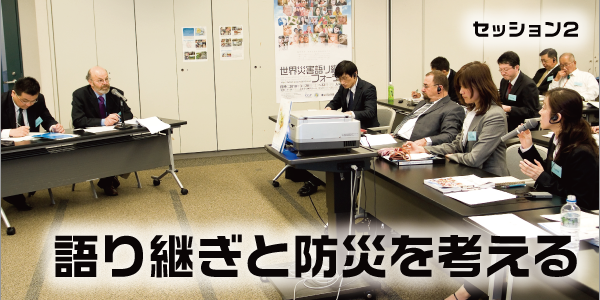
コーディネーター
牧紀男
京都大学防災研究所巨大災害研究センター 准教授
略歴
京都大学防災研究所巨大災害研究センター准教授。
1997年に京都大学大学院工学研究科で博士(工学)を取得。
専門は、ステークホルダー参画型防災戦略計画、災害復興計画、標準的な危機管理システム、すまいの災害誌。
著書「組織の危機管理入門―リスクにどう立ち向えばいいのか (京大人気講義シリーズ)」(丸善)、 「はじめて学ぶ都市計画」(市ヶ谷出版)他
関連情報
京都大学防災研究所巨大災害研究センター
コーディネーター
リチャード・アイズナー
京都大学防災研究所巨大災害研究センター客員教授(2010年3月現在)
略歴
In January 2010, Richard Eisner was appointed as a Visiting Professor at the Research Center for Disaster Reduction Systems, DPRI, at Kyoto University.
Prior to joining DRS, he served as the Government Liaison with Fritz Institute in developing the Bay Area Disaster Preparedness Initiative, after 23 years of service with the California Governor's Office of Emergency Services (OES) where he had served as Manager for the California Integrated Seismic Network (CISN), Tsunami and Earthquake Programs and as Regional Administrator.
As Coastal Region Administrator, he was responsible for the State's responses to disasters in the San Francisco Bay Region and north coast counties Prior to that appointment he served as the founding Director of the Bay Area Regional Earthquake Preparedness Project (BAREPP), a FEMA and state funded program, providing planning and technical assistance to promote and support earthquake preparedness and hazard mitigation by local governments and businesses throughout the San Francisco Bay Region.
サイクロン:1970
Bangladesh is one of the most disaster-prone countries in the world. Due to weak socio-economic and physical infrastructure, the impact of disaster is always high on the life and livelihood of the poor and the disadvantaged. The poor live in high disaster risk areas not by choice, but by compulsion as their socio-economic condition do not allow them to do otherwise. They risk their lives only to earn a subsistence living. They are exploited socially, economically and politically. So, the root cause of their vulnerabilities to disasters is not the exposure to hazards, but 'exploitation'.
Living in disaster-prone areas for hundreds of years have taught the disaster vulnerable people indigenous coping strategies and survival techniques e.g. floating at the height of tidal surge during tropical cyclone with indigenous life jacket made of dry coconut; climbing tall trees and tying with tree trunks for protection from tidal surge; using rafts made of banana plants for evacuation, even living on it for days during the peak of the flood, etc.
Lessons of these indigenous survival techniques passed through generations by various means e.g. telling live lessons through maternal hierarchy (from grandma to mother, to daughter, and the granddaughter). Live lessons were also kept alive through popular media such as folk lores, folk songs, open-air-stage performances, etc. These were done by committed and dedicated people who commanded respect and confidence of their fellow community members and villagers.
However, the cyclone of 1970, that killed half a million people in Bangladesh, brought significant change in those practices. Dissemination of live lessons and family level preparedness, done mainly by the elders of the families and community leaders, were replaced by paid workers of NGOs, educational institutions, and government controlled media.
Now a days, 'invasion by NGOs' (who are entirely dependent on foreign donors, except for a very few) is thrusting upon disaster vulnerable poor people ideas of coping with disasters in a 'top down' and 'donor-driven' way. Dust collecting glossy publications and profit making digital and electronic media are replacing the age old effective practices of 'telling live lessons'. All these are not only far from the traditional culture of the largely rural Bangladesh but also destroying the very cultural fabric of the society. Moreover these are devoid of commitment and dedication that we used to boast of in Bangladesh.
Therefore, we need to go back to our traditional culture and age old practices of telling live lessons for effective disaster risk reduction of the poor.
ムハンマド・サイデュール・ラーマン
バングラデシュ災害予防センター所長
略歴
ムハンマド・サイデュール・ラーマンは災害軽減対策の専門とするバングラデシュ災害予防センター(BDPC)の創設者である。センターを設立(1991年)以前は、20年間にわたって赤十字及びオックスファムUKに勤務し、初代サイクロン予防事業部長、バングラデシュ赤十字副総裁、オックスファム・バングラデシュ常駐代表を務めた。
オーストラリア災害対策局防災大学卒業、1972年から1991年までバングラデシュ及び数回はソマリアでも多くの災害救援及び復興事業に従事。UNDP、ユニセフ及び二国間援助機関(イギリス海外開発局含む)の助成を得て、研究者を指揮して、災害対策に関する基礎的な事項に係る実践的な研究活動を推進。
ラーマンは、災害対策の考え方を事後対応から事前のリスク軽減にシフトするため、容赦なく最善を尽くしてきた。そして、人々の権利を確立するために持続可能な生活支援を提供することを通じて、災害に脆弱な地域の能力向上という考え方を推進している。
バングラデシュで広く使われている「バングラデシュ災害対策ハンドブック」など、著書多数。国連国際防災戦略から、2002年自然災害軽減のための国連笹川賞受賞。
関連情報
バングラデシュ災害予防センター
アモッド・マニ・ディクシット
ネパール地震技術協会(NSET)会長
略歴
ディクシット氏はペテルスブルク大学とアジア工科大学で学んだ。氏は、20年に及ぶネパール政府での勤務、技術コンサルタント企業での勤務、技術地理学の客員教授など、35年以上の専門的な経験を有している。また、1994年に、ネパールを本拠地とするNGOであり、地震リスク管理を専門とするネパール地震技術協会(NSET)を設立して会長を務め、ネパール及び他のアジア各国での災害リスク軽減事業の実施に関わってきている。
関連情報
ネパール地震技術協会(NSET)
バム地震:2003
For the first time after a major earthquake in Iran, problems, comments and issues of affected people has been analyzed through a local newsletter. This paper will provide a brief description of needs of earthquake stricken people in Bam by reviewing the news values of different variables in a local newsletter within a period of two years. After the Bam earthquake on December 26 of 2003, the affected people needed a media in order to express their experiences, comments and difficulties and also to be aware of activities around them. For dissemination of information among the people many pamphlets and newsletters have been distributed in the city after an earthquake, but one newsletter has been published systematically for exchange of information in the region. In this article the news values of different issues and variable of this newsletter for a period of two years will be reviewed by content analysis.
ファロック・パルシザデー(欠席)
イラン国際地震工学・地震学研究所災害管理部研究員
略歴
関連情報
防災教育
顧 林生
精華大学都市計画設計研究院公共安全研究所 所長
略歴
関連情報
~アルジェリアのケース~
ブーメルデス地震:2003
2003年のブーメルデス地震の後、アルジェリア地域防衛総局が2004年にその本部敷地内にミュージアムを設立し、管理運営にあたっている。自然災害に関するミュージアムはアルジェの国立地域防衛ミュージアム内にある。来館者は主に児童生徒(年間約1200人)と一般市民(年間約250人)である。博物館の見学は、災害予防の教育という点で実地の教育訓練授業である。この考え方は学校の教師や児童はもちろん、一般市民にもよく理解されている。
ミュージアム設立にあたって地域防衛総局は芸術家を招集し、地震、洪水、山火事等における避難所や応急対応、救援活動など、災害の状況を紹介する模型の制作を依頼した。災害を記憶し、これを忘れることなく人々がリスクとともに生活するようになってもらいたい。ミュージアムでは、訓練された職員や災害時に応急対応や救援活動に加わった人々が解説員となり、また他の活動も担っている。
地域防衛総局は平時には主として全国各地で地震や洪水、火災などの訓練を実施している。残念ながら地域の人々はミュージアムの活動には参画していない。当然のことながら、いくつかの団体や大学が、毎年大きな災害を記念行事を実施し、何がどのように起きたのかを語り継ぎ、将来の災害リスクを軽減するための方策などの周知を行っている。特に過去の災害の被災地では毎年いろいろな会議が開催され、一般市民も招待されている。また、内輪の集まりで人々はしばしば災害の時に起きたことがらについて語り継いでいる。口頭伝承の文化が根付いており、人々は家族の集まりなどでさまざまな語り継ぎを行うことに慣れ親しんでいる。
私は、ミュージアムでは、災害の様子を展示するだけでなく、災害の復興についても社会的、経済的、文化的、物的な側面から紹介すべきだと考えている。アルジェリア北部のようなリスク環境における人間社会の発展を促進すべきだ。このようなミュージアムが構想され、国中の他の都市にも広がっていくことが計画されている。
ジッラリ・ベヌーアール
ブ・エッズーアール大学 土木工学科 市街地環境調査研究所 教授、所長
略歴
関連情報
バブ・エッズーアール大学
自然災害の多くは、地理条件が影響を及ぼすことから、同じ地域で繰り返し発生する可能性がある。従って、被災した地域では、災害復興過程において将来的な被害を軽減するための防災対策が重要となる。そのための方策の一つとして、その地域で発生した被災の記憶を忘却させずに留め、それによる教訓を防災対策に活かすことが挙げられる。ただし、記憶は多様なものであり、どのような記憶が、どのように継承されているのかは明らかにされていない。本研究においては、巨大災害に襲われた後10年以上が経過しつつある地域において、災害復興過程においてどのような記憶が留められようとしているのか、それが、防災対策を促す資源となり得るのかを検討する。
阪本真由美
京都大学防災研究所巨大災害センター
(2010年4月から人と防災未来センター研究員)
略歴
京都大学大学院情報学研究科・京都産業大学非常勤講師。在エル・サルヴァドル日本大使館専門調査員、国際協力機構(JICA)勤務を経て現在に至る。専門は、国際協力論、災害復興支援。
関連情報
発表者は,中学生の時に災害を経験した研究者である。研究活動の傍ら出前授業や講演などを行う中で,聞き手の年齢や職業,居住地などにより,求められる話の内容や,その反応が大きく異なることに気づいた。そこで,本報告ではこれまでの研究・アウトリーチ活動の中から,対象者別の「語り継ぎ」の効果的な手法について,「研究者」であり「語り部」である報告者の視点から述べる。
定池祐季
北海道大学大学院文学研究科
(2010年4月から人と防災未来センター研究員)
略歴
生粋の道産子。1993年7月12日,奥尻島で北海道南西沖地震に遭遇したのがきっかけとなり,災害研究を志す。専門は地域社会学,災害社会学。奥尻島や有珠山周辺地域を中心にフィールドワークを展開しつつ,自らの被災体験と研究成果を組み合わせた授業や講演などの活動を行っている。
関連情報
Copyright c 2011 TeLL-Net All Rights Reserved.

